Southern Cross University: Brown v Tasmania Case Study Analysis
VerifiedAdded on 2022/10/18
|9
|2303
|233
Case Study
AI Summary
This case study analyzes the High Court case of Brown v Tasmania (2017) concerning the implied freedom of political communication within the context of Tasmanian forestry protests. The case revolves around the validity of the Workplace (Protection from Protesters) Act 2014 (Tas), which aimed to restrict protests on forestry lands. The case study meticulously outlines the facts, legal issues, and the reasoning of both the majority and dissenting judges, highlighting the central debate on whether the Act unduly burdened political communication. The majority found that the provisions were invalid, while dissenting judges had differing opinions on the Act's validity. Furthermore, the case study examines the significance of the decision in terms of constitutional law development, emphasizing its implications for freedom of speech and the balance between governmental regulation and individual rights. It explores the political and social significance of the case, including the High Court's consideration of these factors in their judgments. The case study provides a comprehensive overview of the legal arguments, the Court's analysis, and the broader implications of the decision for the protection of political expression in Australia.
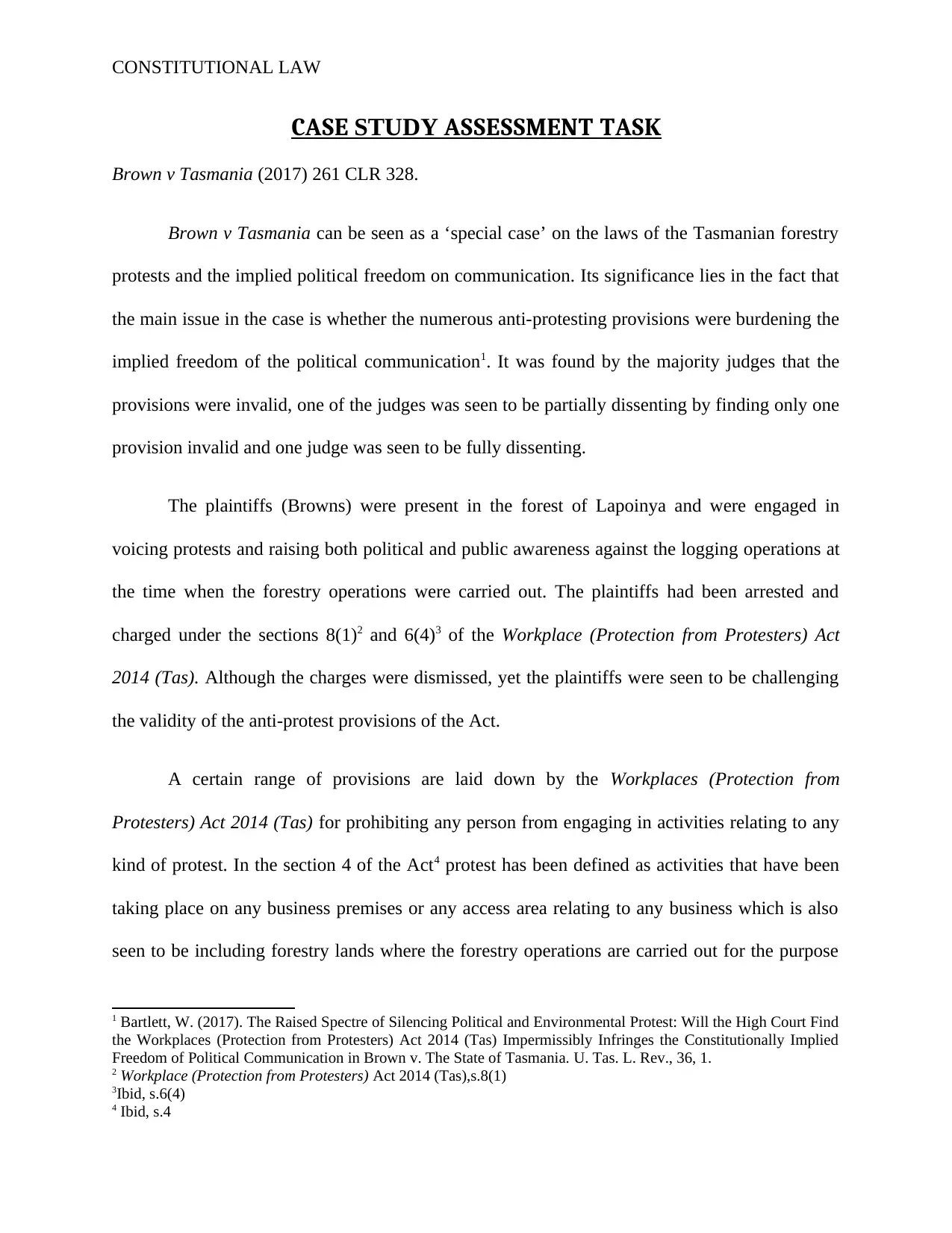
CONSTITUTIONAL LAW
CASE STUDY ASSESSMENT TASK
Brown v Tasmania (2017) 261 CLR 328.
Brown v Tasmania can be seen as a ‘special case’ on the laws of the Tasmanian forestry
protests and the implied political freedom on communication. Its significance lies in the fact that
the main issue in the case is whether the numerous anti-protesting provisions were burdening the
implied freedom of the political communication1. It was found by the majority judges that the
provisions were invalid, one of the judges was seen to be partially dissenting by finding only one
provision invalid and one judge was seen to be fully dissenting.
The plaintiffs (Browns) were present in the forest of Lapoinya and were engaged in
voicing protests and raising both political and public awareness against the logging operations at
the time when the forestry operations were carried out. The plaintiffs had been arrested and
charged under the sections 8(1)2 and 6(4)3 of the Workplace (Protection from Protesters) Act
2014 (Tas). Although the charges were dismissed, yet the plaintiffs were seen to be challenging
the validity of the anti-protest provisions of the Act.
A certain range of provisions are laid down by the Workplaces (Protection from
Protesters) Act 2014 (Tas) for prohibiting any person from engaging in activities relating to any
kind of protest. In the section 4 of the Act4 protest has been defined as activities that have been
taking place on any business premises or any access area relating to any business which is also
seen to be including forestry lands where the forestry operations are carried out for the purpose
1 Bartlett, W. (2017). The Raised Spectre of Silencing Political and Environmental Protest: Will the High Court Find
the Workplaces (Protection from Protesters) Act 2014 (Tas) Impermissibly Infringes the Constitutionally Implied
Freedom of Political Communication in Brown v. The State of Tasmania. U. Tas. L. Rev., 36, 1.
2 Workplace (Protection from Protesters) Act 2014 (Tas),s.8(1)
3Ibid, s.6(4)
4 Ibid, s.4
CASE STUDY ASSESSMENT TASK
Brown v Tasmania (2017) 261 CLR 328.
Brown v Tasmania can be seen as a ‘special case’ on the laws of the Tasmanian forestry
protests and the implied political freedom on communication. Its significance lies in the fact that
the main issue in the case is whether the numerous anti-protesting provisions were burdening the
implied freedom of the political communication1. It was found by the majority judges that the
provisions were invalid, one of the judges was seen to be partially dissenting by finding only one
provision invalid and one judge was seen to be fully dissenting.
The plaintiffs (Browns) were present in the forest of Lapoinya and were engaged in
voicing protests and raising both political and public awareness against the logging operations at
the time when the forestry operations were carried out. The plaintiffs had been arrested and
charged under the sections 8(1)2 and 6(4)3 of the Workplace (Protection from Protesters) Act
2014 (Tas). Although the charges were dismissed, yet the plaintiffs were seen to be challenging
the validity of the anti-protest provisions of the Act.
A certain range of provisions are laid down by the Workplaces (Protection from
Protesters) Act 2014 (Tas) for prohibiting any person from engaging in activities relating to any
kind of protest. In the section 4 of the Act4 protest has been defined as activities that have been
taking place on any business premises or any access area relating to any business which is also
seen to be including forestry lands where the forestry operations are carried out for the purpose
1 Bartlett, W. (2017). The Raised Spectre of Silencing Political and Environmental Protest: Will the High Court Find
the Workplaces (Protection from Protesters) Act 2014 (Tas) Impermissibly Infringes the Constitutionally Implied
Freedom of Political Communication in Brown v. The State of Tasmania. U. Tas. L. Rev., 36, 1.
2 Workplace (Protection from Protesters) Act 2014 (Tas),s.8(1)
3Ibid, s.6(4)
4 Ibid, s.4
Paraphrase This Document
Need a fresh take? Get an instant paraphrase of this document with our AI Paraphraser
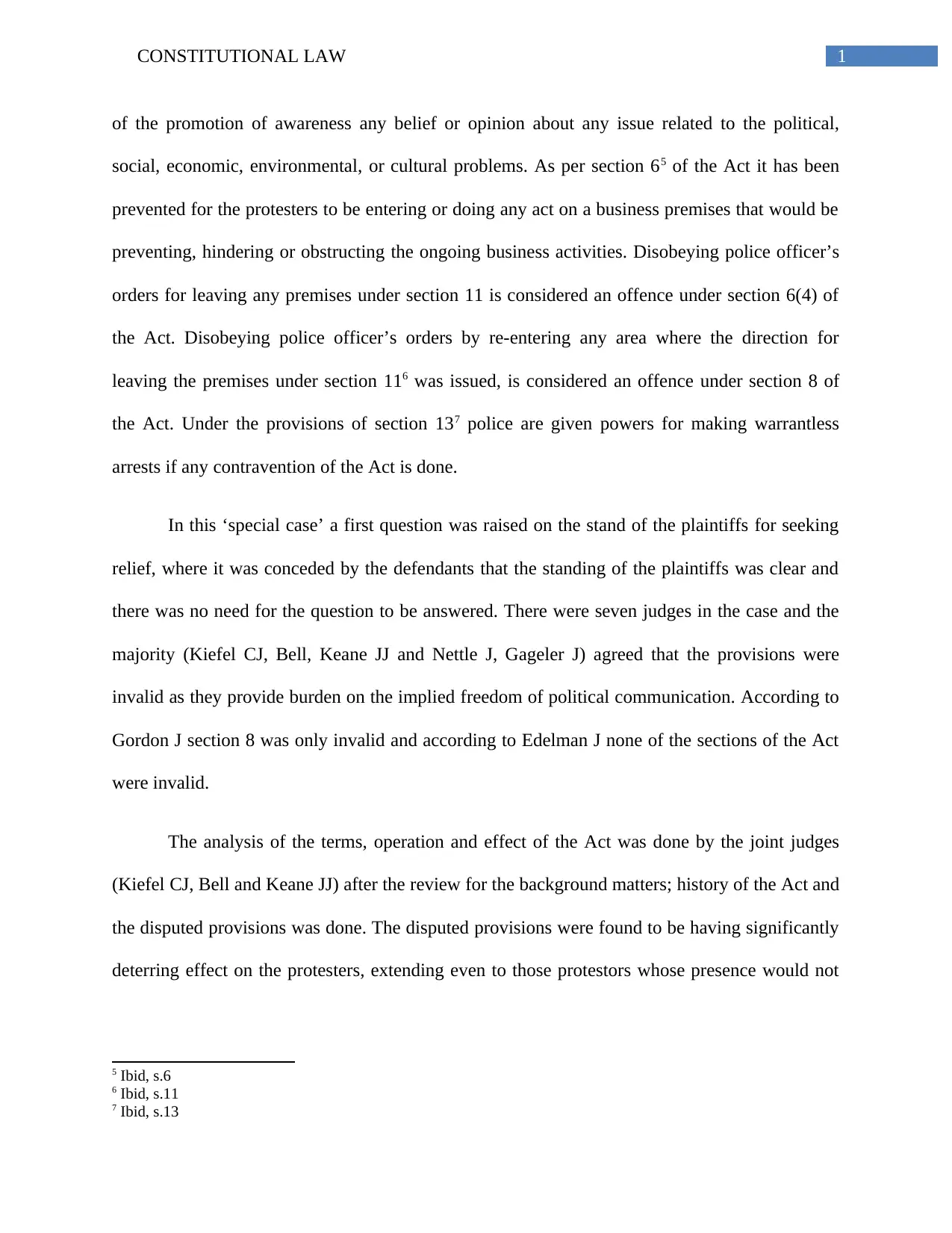
1CONSTITUTIONAL LAW
of the promotion of awareness any belief or opinion about any issue related to the political,
social, economic, environmental, or cultural problems. As per section 65 of the Act it has been
prevented for the protesters to be entering or doing any act on a business premises that would be
preventing, hindering or obstructing the ongoing business activities. Disobeying police officer’s
orders for leaving any premises under section 11 is considered an offence under section 6(4) of
the Act. Disobeying police officer’s orders by re-entering any area where the direction for
leaving the premises under section 116 was issued, is considered an offence under section 8 of
the Act. Under the provisions of section 137 police are given powers for making warrantless
arrests if any contravention of the Act is done.
In this ‘special case’ a first question was raised on the stand of the plaintiffs for seeking
relief, where it was conceded by the defendants that the standing of the plaintiffs was clear and
there was no need for the question to be answered. There were seven judges in the case and the
majority (Kiefel CJ, Bell, Keane JJ and Nettle J, Gageler J) agreed that the provisions were
invalid as they provide burden on the implied freedom of political communication. According to
Gordon J section 8 was only invalid and according to Edelman J none of the sections of the Act
were invalid.
The analysis of the terms, operation and effect of the Act was done by the joint judges
(Kiefel CJ, Bell and Keane JJ) after the review for the background matters; history of the Act and
the disputed provisions was done. The disputed provisions were found to be having significantly
deterring effect on the protesters, extending even to those protestors whose presence would not
5 Ibid, s.6
6 Ibid, s.11
7 Ibid, s.13
of the promotion of awareness any belief or opinion about any issue related to the political,
social, economic, environmental, or cultural problems. As per section 65 of the Act it has been
prevented for the protesters to be entering or doing any act on a business premises that would be
preventing, hindering or obstructing the ongoing business activities. Disobeying police officer’s
orders for leaving any premises under section 11 is considered an offence under section 6(4) of
the Act. Disobeying police officer’s orders by re-entering any area where the direction for
leaving the premises under section 116 was issued, is considered an offence under section 8 of
the Act. Under the provisions of section 137 police are given powers for making warrantless
arrests if any contravention of the Act is done.
In this ‘special case’ a first question was raised on the stand of the plaintiffs for seeking
relief, where it was conceded by the defendants that the standing of the plaintiffs was clear and
there was no need for the question to be answered. There were seven judges in the case and the
majority (Kiefel CJ, Bell, Keane JJ and Nettle J, Gageler J) agreed that the provisions were
invalid as they provide burden on the implied freedom of political communication. According to
Gordon J section 8 was only invalid and according to Edelman J none of the sections of the Act
were invalid.
The analysis of the terms, operation and effect of the Act was done by the joint judges
(Kiefel CJ, Bell and Keane JJ) after the review for the background matters; history of the Act and
the disputed provisions was done. The disputed provisions were found to be having significantly
deterring effect on the protesters, extending even to those protestors whose presence would not
5 Ibid, s.6
6 Ibid, s.11
7 Ibid, s.13
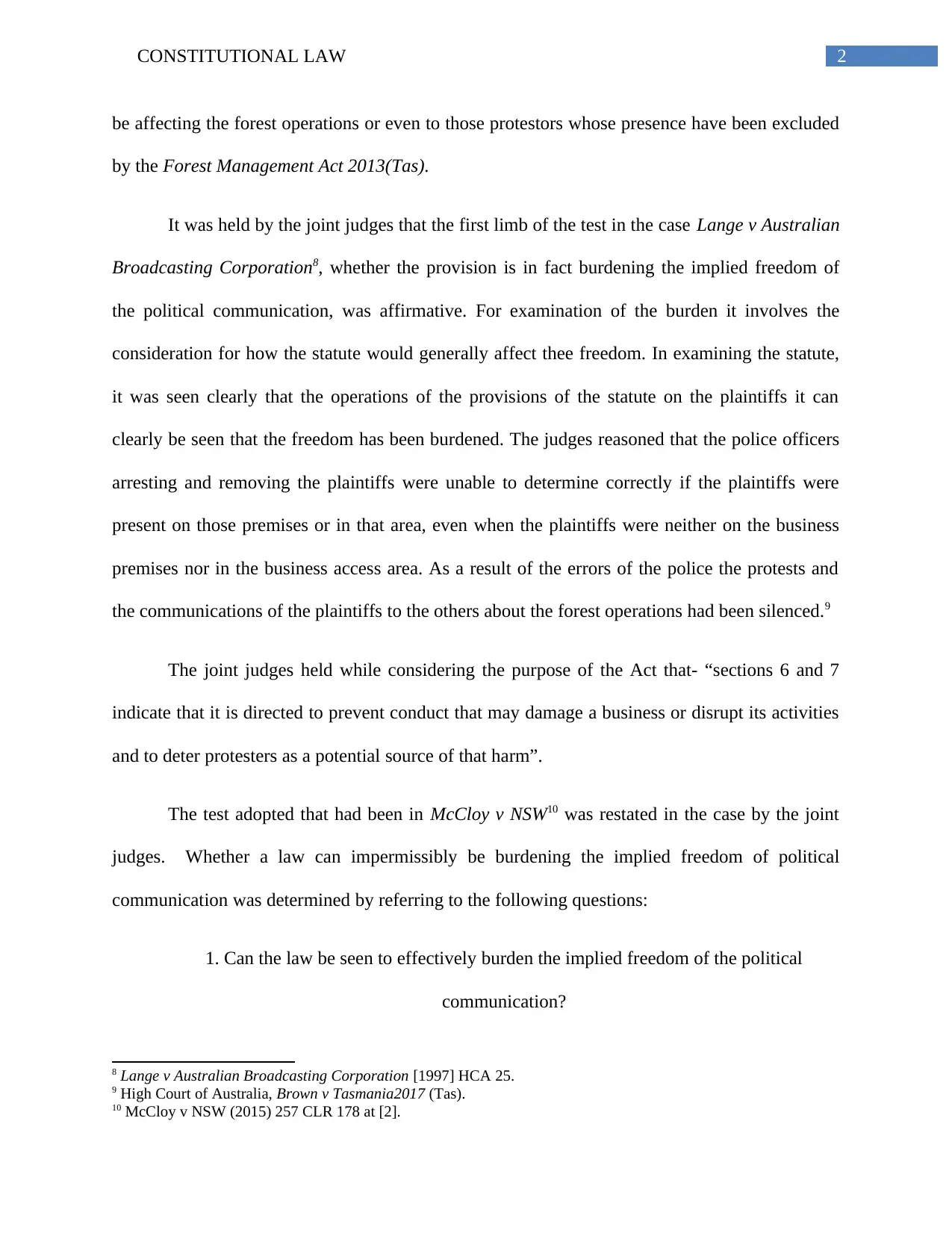
2CONSTITUTIONAL LAW
be affecting the forest operations or even to those protestors whose presence have been excluded
by the Forest Management Act 2013(Tas).
It was held by the joint judges that the first limb of the test in the case Lange v Australian
Broadcasting Corporation8, whether the provision is in fact burdening the implied freedom of
the political communication, was affirmative. For examination of the burden it involves the
consideration for how the statute would generally affect thee freedom. In examining the statute,
it was seen clearly that the operations of the provisions of the statute on the plaintiffs it can
clearly be seen that the freedom has been burdened. The judges reasoned that the police officers
arresting and removing the plaintiffs were unable to determine correctly if the plaintiffs were
present on those premises or in that area, even when the plaintiffs were neither on the business
premises nor in the business access area. As a result of the errors of the police the protests and
the communications of the plaintiffs to the others about the forest operations had been silenced.9
The joint judges held while considering the purpose of the Act that- “sections 6 and 7
indicate that it is directed to prevent conduct that may damage a business or disrupt its activities
and to deter protesters as a potential source of that harm”.
The test adopted that had been in McCloy v NSW10 was restated in the case by the joint
judges. Whether a law can impermissibly be burdening the implied freedom of political
communication was determined by referring to the following questions:
1. Can the law be seen to effectively burden the implied freedom of the political
communication?
8 Lange v Australian Broadcasting Corporation [1997] HCA 25.
9 High Court of Australia, Brown v Tasmania2017 (Tas).
10 McCloy v NSW (2015) 257 CLR 178 at [2].
be affecting the forest operations or even to those protestors whose presence have been excluded
by the Forest Management Act 2013(Tas).
It was held by the joint judges that the first limb of the test in the case Lange v Australian
Broadcasting Corporation8, whether the provision is in fact burdening the implied freedom of
the political communication, was affirmative. For examination of the burden it involves the
consideration for how the statute would generally affect thee freedom. In examining the statute,
it was seen clearly that the operations of the provisions of the statute on the plaintiffs it can
clearly be seen that the freedom has been burdened. The judges reasoned that the police officers
arresting and removing the plaintiffs were unable to determine correctly if the plaintiffs were
present on those premises or in that area, even when the plaintiffs were neither on the business
premises nor in the business access area. As a result of the errors of the police the protests and
the communications of the plaintiffs to the others about the forest operations had been silenced.9
The joint judges held while considering the purpose of the Act that- “sections 6 and 7
indicate that it is directed to prevent conduct that may damage a business or disrupt its activities
and to deter protesters as a potential source of that harm”.
The test adopted that had been in McCloy v NSW10 was restated in the case by the joint
judges. Whether a law can impermissibly be burdening the implied freedom of political
communication was determined by referring to the following questions:
1. Can the law be seen to effectively burden the implied freedom of the political
communication?
8 Lange v Australian Broadcasting Corporation [1997] HCA 25.
9 High Court of Australia, Brown v Tasmania2017 (Tas).
10 McCloy v NSW (2015) 257 CLR 178 at [2].
⊘ This is a preview!⊘
Do you want full access?
Subscribe today to unlock all pages.

Trusted by 1+ million students worldwide
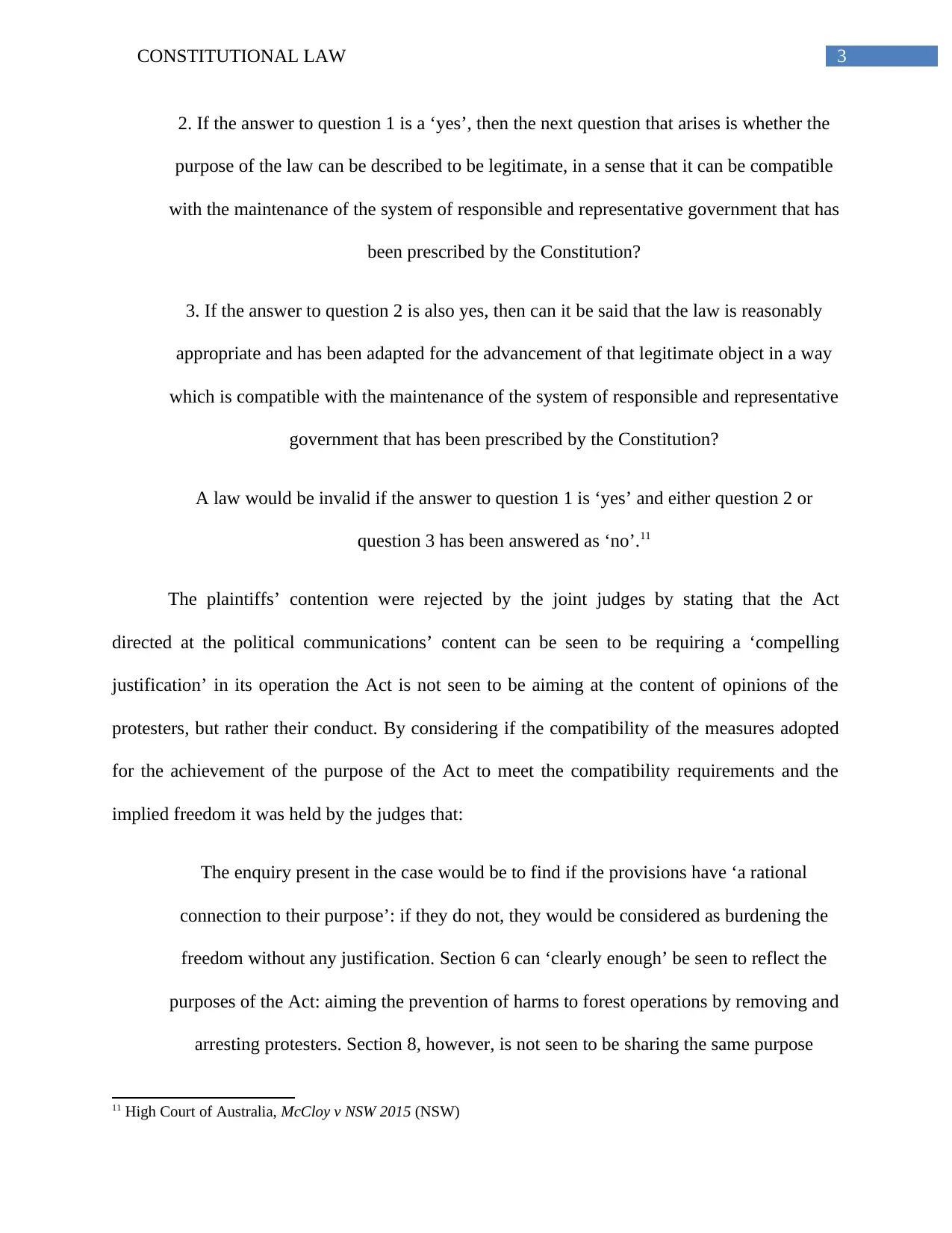
3CONSTITUTIONAL LAW
2. If the answer to question 1 is a ‘yes’, then the next question that arises is whether the
purpose of the law can be described to be legitimate, in a sense that it can be compatible
with the maintenance of the system of responsible and representative government that has
been prescribed by the Constitution?
3. If the answer to question 2 is also yes, then can it be said that the law is reasonably
appropriate and has been adapted for the advancement of that legitimate object in a way
which is compatible with the maintenance of the system of responsible and representative
government that has been prescribed by the Constitution?
A law would be invalid if the answer to question 1 is ‘yes’ and either question 2 or
question 3 has been answered as ‘no’.11
The plaintiffs’ contention were rejected by the joint judges by stating that the Act
directed at the political communications’ content can be seen to be requiring a ‘compelling
justification’ in its operation the Act is not seen to be aiming at the content of opinions of the
protesters, but rather their conduct. By considering if the compatibility of the measures adopted
for the achievement of the purpose of the Act to meet the compatibility requirements and the
implied freedom it was held by the judges that:
The enquiry present in the case would be to find if the provisions have ‘a rational
connection to their purpose’: if they do not, they would be considered as burdening the
freedom without any justification. Section 6 can ‘clearly enough’ be seen to reflect the
purposes of the Act: aiming the prevention of harms to forest operations by removing and
arresting protesters. Section 8, however, is not seen to be sharing the same purpose
11 High Court of Australia, McCloy v NSW 2015 (NSW)
2. If the answer to question 1 is a ‘yes’, then the next question that arises is whether the
purpose of the law can be described to be legitimate, in a sense that it can be compatible
with the maintenance of the system of responsible and representative government that has
been prescribed by the Constitution?
3. If the answer to question 2 is also yes, then can it be said that the law is reasonably
appropriate and has been adapted for the advancement of that legitimate object in a way
which is compatible with the maintenance of the system of responsible and representative
government that has been prescribed by the Constitution?
A law would be invalid if the answer to question 1 is ‘yes’ and either question 2 or
question 3 has been answered as ‘no’.11
The plaintiffs’ contention were rejected by the joint judges by stating that the Act
directed at the political communications’ content can be seen to be requiring a ‘compelling
justification’ in its operation the Act is not seen to be aiming at the content of opinions of the
protesters, but rather their conduct. By considering if the compatibility of the measures adopted
for the achievement of the purpose of the Act to meet the compatibility requirements and the
implied freedom it was held by the judges that:
The enquiry present in the case would be to find if the provisions have ‘a rational
connection to their purpose’: if they do not, they would be considered as burdening the
freedom without any justification. Section 6 can ‘clearly enough’ be seen to reflect the
purposes of the Act: aiming the prevention of harms to forest operations by removing and
arresting protesters. Section 8, however, is not seen to be sharing the same purpose
11 High Court of Australia, McCloy v NSW 2015 (NSW)
Paraphrase This Document
Need a fresh take? Get an instant paraphrase of this document with our AI Paraphraser
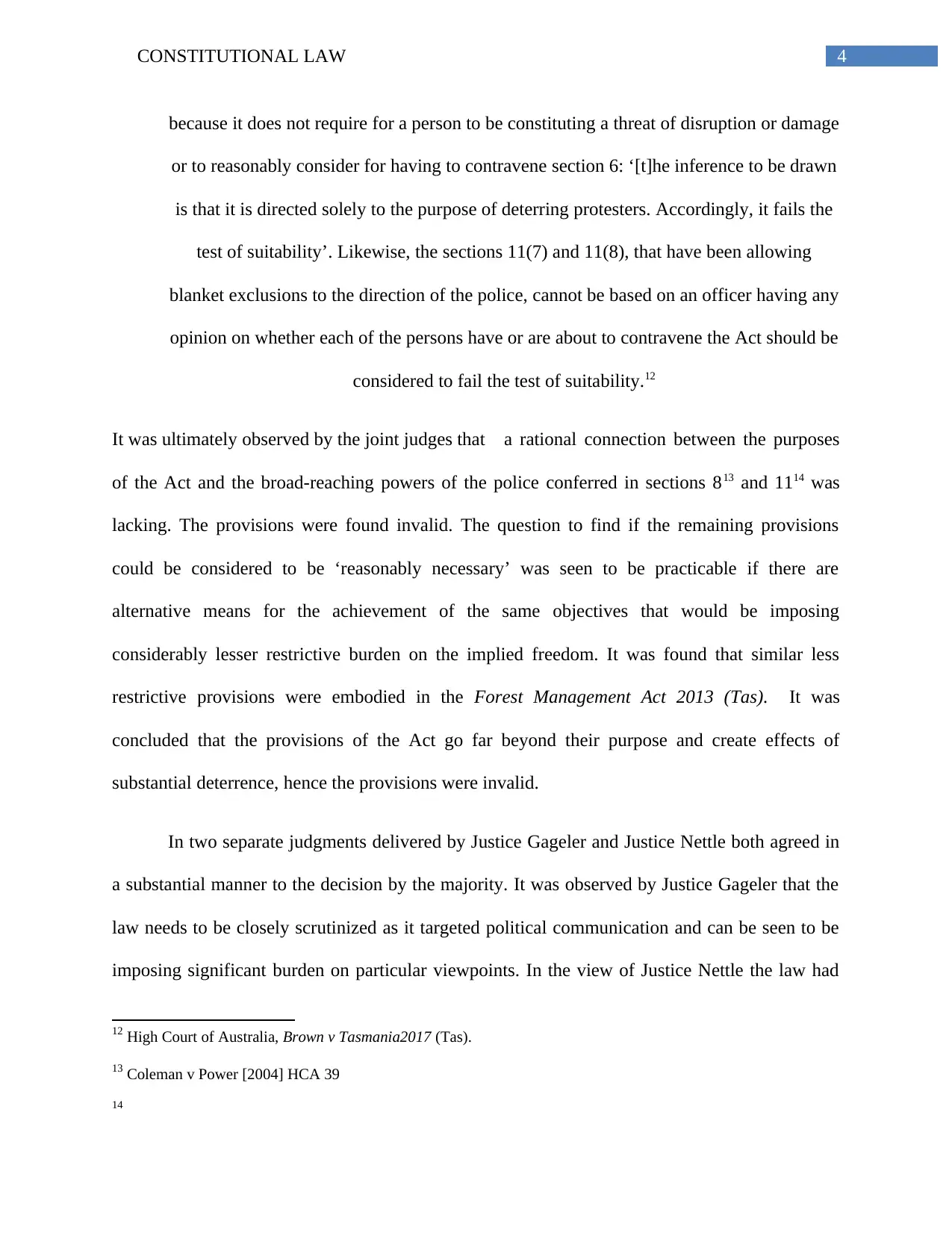
4CONSTITUTIONAL LAW
because it does not require for a person to be constituting a threat of disruption or damage
or to reasonably consider for having to contravene section 6: ‘[t]he inference to be drawn
is that it is directed solely to the purpose of deterring protesters. Accordingly, it fails the
test of suitability’. Likewise, the sections 11(7) and 11(8), that have been allowing
blanket exclusions to the direction of the police, cannot be based on an officer having any
opinion on whether each of the persons have or are about to contravene the Act should be
considered to fail the test of suitability.12
It was ultimately observed by the joint judges that a rational connection between the purposes
of the Act and the broad-reaching powers of the police conferred in sections 813 and 1114 was
lacking. The provisions were found invalid. The question to find if the remaining provisions
could be considered to be ‘reasonably necessary’ was seen to be practicable if there are
alternative means for the achievement of the same objectives that would be imposing
considerably lesser restrictive burden on the implied freedom. It was found that similar less
restrictive provisions were embodied in the Forest Management Act 2013 (Tas). It was
concluded that the provisions of the Act go far beyond their purpose and create effects of
substantial deterrence, hence the provisions were invalid.
In two separate judgments delivered by Justice Gageler and Justice Nettle both agreed in
a substantial manner to the decision by the majority. It was observed by Justice Gageler that the
law needs to be closely scrutinized as it targeted political communication and can be seen to be
imposing significant burden on particular viewpoints. In the view of Justice Nettle the law had
12 High Court of Australia, Brown v Tasmania2017 (Tas).
13 Coleman v Power [2004] HCA 39
14
because it does not require for a person to be constituting a threat of disruption or damage
or to reasonably consider for having to contravene section 6: ‘[t]he inference to be drawn
is that it is directed solely to the purpose of deterring protesters. Accordingly, it fails the
test of suitability’. Likewise, the sections 11(7) and 11(8), that have been allowing
blanket exclusions to the direction of the police, cannot be based on an officer having any
opinion on whether each of the persons have or are about to contravene the Act should be
considered to fail the test of suitability.12
It was ultimately observed by the joint judges that a rational connection between the purposes
of the Act and the broad-reaching powers of the police conferred in sections 813 and 1114 was
lacking. The provisions were found invalid. The question to find if the remaining provisions
could be considered to be ‘reasonably necessary’ was seen to be practicable if there are
alternative means for the achievement of the same objectives that would be imposing
considerably lesser restrictive burden on the implied freedom. It was found that similar less
restrictive provisions were embodied in the Forest Management Act 2013 (Tas). It was
concluded that the provisions of the Act go far beyond their purpose and create effects of
substantial deterrence, hence the provisions were invalid.
In two separate judgments delivered by Justice Gageler and Justice Nettle both agreed in
a substantial manner to the decision by the majority. It was observed by Justice Gageler that the
law needs to be closely scrutinized as it targeted political communication and can be seen to be
imposing significant burden on particular viewpoints. In the view of Justice Nettle the law had
12 High Court of Australia, Brown v Tasmania2017 (Tas).
13 Coleman v Power [2004] HCA 39
14
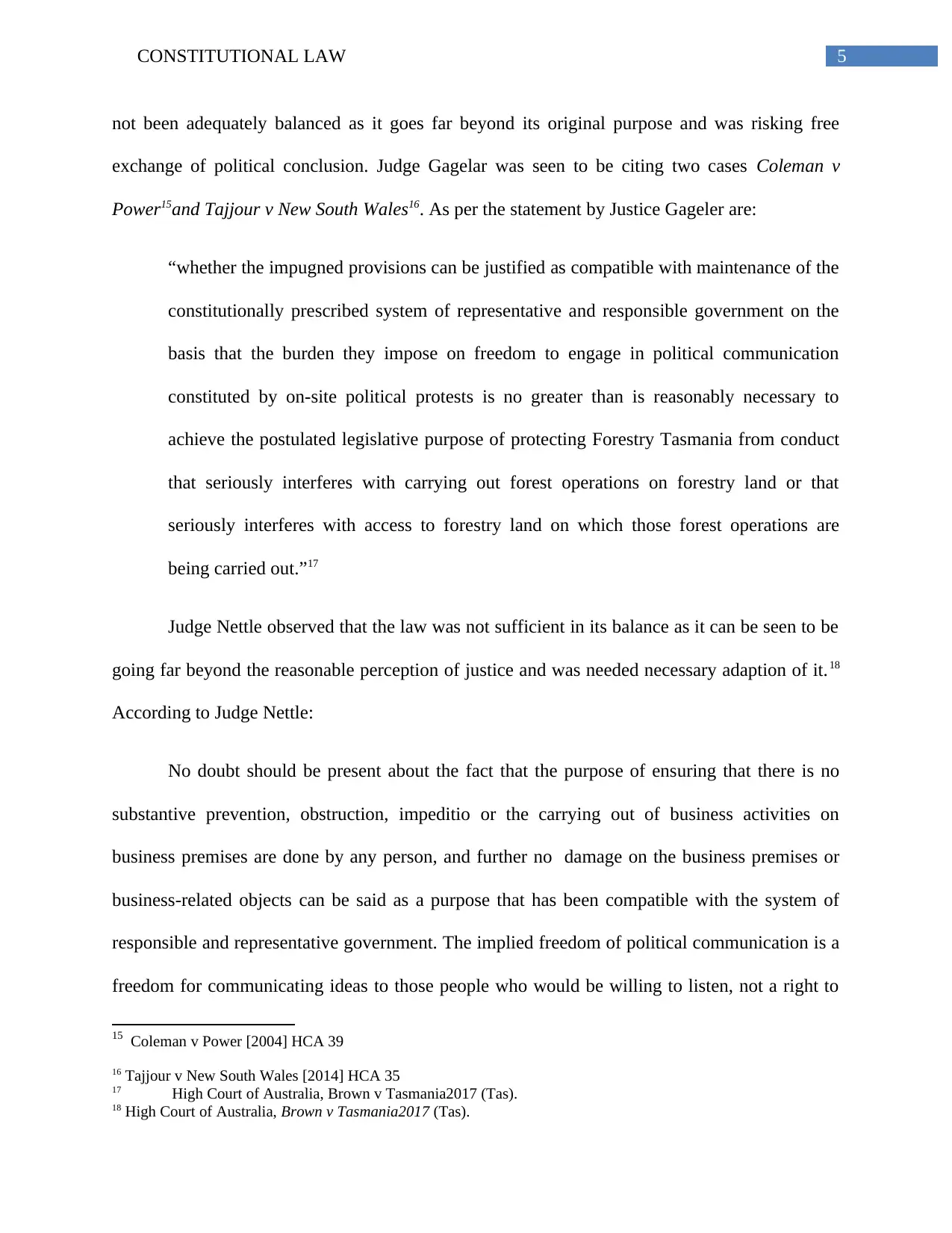
5CONSTITUTIONAL LAW
not been adequately balanced as it goes far beyond its original purpose and was risking free
exchange of political conclusion. Judge Gagelar was seen to be citing two cases Coleman v
Power15and Tajjour v New South Wales16. As per the statement by Justice Gageler are:
“whether the impugned provisions can be justified as compatible with maintenance of the
constitutionally prescribed system of representative and responsible government on the
basis that the burden they impose on freedom to engage in political communication
constituted by on-site political protests is no greater than is reasonably necessary to
achieve the postulated legislative purpose of protecting Forestry Tasmania from conduct
that seriously interferes with carrying out forest operations on forestry land or that
seriously interferes with access to forestry land on which those forest operations are
being carried out.”17
Judge Nettle observed that the law was not sufficient in its balance as it can be seen to be
going far beyond the reasonable perception of justice and was needed necessary adaption of it.18
According to Judge Nettle:
No doubt should be present about the fact that the purpose of ensuring that there is no
substantive prevention, obstruction, impeditio or the carrying out of business activities on
business premises are done by any person, and further no damage on the business premises or
business-related objects can be said as a purpose that has been compatible with the system of
responsible and representative government. The implied freedom of political communication is a
freedom for communicating ideas to those people who would be willing to listen, not a right to
15 Coleman v Power [2004] HCA 39
16 Tajjour v New South Wales [2014] HCA 35
17 High Court of Australia, Brown v Tasmania2017 (Tas).
18 High Court of Australia, Brown v Tasmania2017 (Tas).
not been adequately balanced as it goes far beyond its original purpose and was risking free
exchange of political conclusion. Judge Gagelar was seen to be citing two cases Coleman v
Power15and Tajjour v New South Wales16. As per the statement by Justice Gageler are:
“whether the impugned provisions can be justified as compatible with maintenance of the
constitutionally prescribed system of representative and responsible government on the
basis that the burden they impose on freedom to engage in political communication
constituted by on-site political protests is no greater than is reasonably necessary to
achieve the postulated legislative purpose of protecting Forestry Tasmania from conduct
that seriously interferes with carrying out forest operations on forestry land or that
seriously interferes with access to forestry land on which those forest operations are
being carried out.”17
Judge Nettle observed that the law was not sufficient in its balance as it can be seen to be
going far beyond the reasonable perception of justice and was needed necessary adaption of it.18
According to Judge Nettle:
No doubt should be present about the fact that the purpose of ensuring that there is no
substantive prevention, obstruction, impeditio or the carrying out of business activities on
business premises are done by any person, and further no damage on the business premises or
business-related objects can be said as a purpose that has been compatible with the system of
responsible and representative government. The implied freedom of political communication is a
freedom for communicating ideas to those people who would be willing to listen, not a right to
15 Coleman v Power [2004] HCA 39
16 Tajjour v New South Wales [2014] HCA 35
17 High Court of Australia, Brown v Tasmania2017 (Tas).
18 High Court of Australia, Brown v Tasmania2017 (Tas).
⊘ This is a preview!⊘
Do you want full access?
Subscribe today to unlock all pages.

Trusted by 1+ million students worldwide
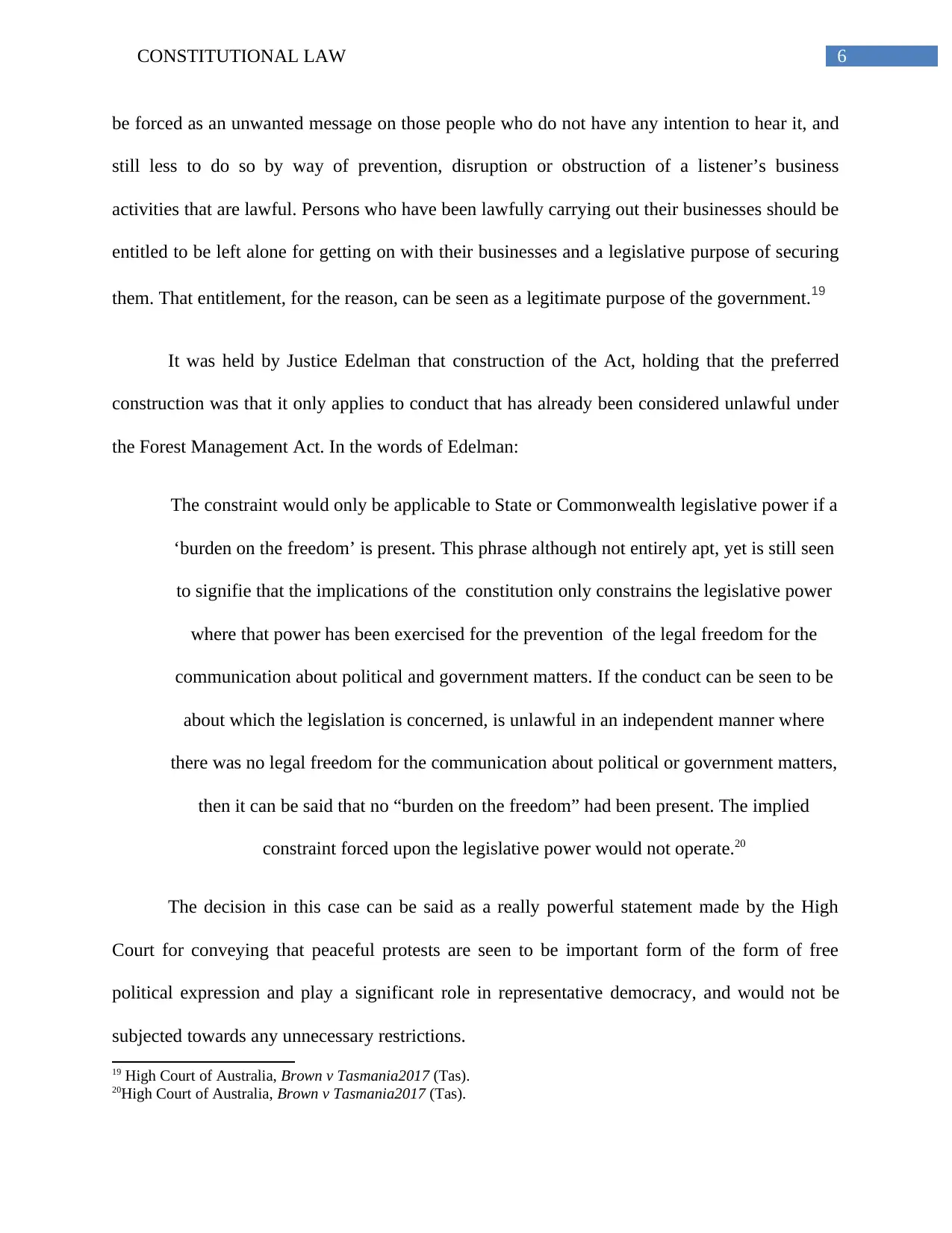
6CONSTITUTIONAL LAW
be forced as an unwanted message on those people who do not have any intention to hear it, and
still less to do so by way of prevention, disruption or obstruction of a listener’s business
activities that are lawful. Persons who have been lawfully carrying out their businesses should be
entitled to be left alone for getting on with their businesses and a legislative purpose of securing
them. That entitlement, for the reason, can be seen as a legitimate purpose of the government.19
It was held by Justice Edelman that construction of the Act, holding that the preferred
construction was that it only applies to conduct that has already been considered unlawful under
the Forest Management Act. In the words of Edelman:
The constraint would only be applicable to State or Commonwealth legislative power if a
‘burden on the freedom’ is present. This phrase although not entirely apt, yet is still seen
to signifie that the implications of the constitution only constrains the legislative power
where that power has been exercised for the prevention of the legal freedom for the
communication about political and government matters. If the conduct can be seen to be
about which the legislation is concerned, is unlawful in an independent manner where
there was no legal freedom for the communication about political or government matters,
then it can be said that no “burden on the freedom” had been present. The implied
constraint forced upon the legislative power would not operate.20
The decision in this case can be said as a really powerful statement made by the High
Court for conveying that peaceful protests are seen to be important form of the form of free
political expression and play a significant role in representative democracy, and would not be
subjected towards any unnecessary restrictions.
19 High Court of Australia, Brown v Tasmania2017 (Tas).
20High Court of Australia, Brown v Tasmania2017 (Tas).
be forced as an unwanted message on those people who do not have any intention to hear it, and
still less to do so by way of prevention, disruption or obstruction of a listener’s business
activities that are lawful. Persons who have been lawfully carrying out their businesses should be
entitled to be left alone for getting on with their businesses and a legislative purpose of securing
them. That entitlement, for the reason, can be seen as a legitimate purpose of the government.19
It was held by Justice Edelman that construction of the Act, holding that the preferred
construction was that it only applies to conduct that has already been considered unlawful under
the Forest Management Act. In the words of Edelman:
The constraint would only be applicable to State or Commonwealth legislative power if a
‘burden on the freedom’ is present. This phrase although not entirely apt, yet is still seen
to signifie that the implications of the constitution only constrains the legislative power
where that power has been exercised for the prevention of the legal freedom for the
communication about political and government matters. If the conduct can be seen to be
about which the legislation is concerned, is unlawful in an independent manner where
there was no legal freedom for the communication about political or government matters,
then it can be said that no “burden on the freedom” had been present. The implied
constraint forced upon the legislative power would not operate.20
The decision in this case can be said as a really powerful statement made by the High
Court for conveying that peaceful protests are seen to be important form of the form of free
political expression and play a significant role in representative democracy, and would not be
subjected towards any unnecessary restrictions.
19 High Court of Australia, Brown v Tasmania2017 (Tas).
20High Court of Australia, Brown v Tasmania2017 (Tas).
Paraphrase This Document
Need a fresh take? Get an instant paraphrase of this document with our AI Paraphraser
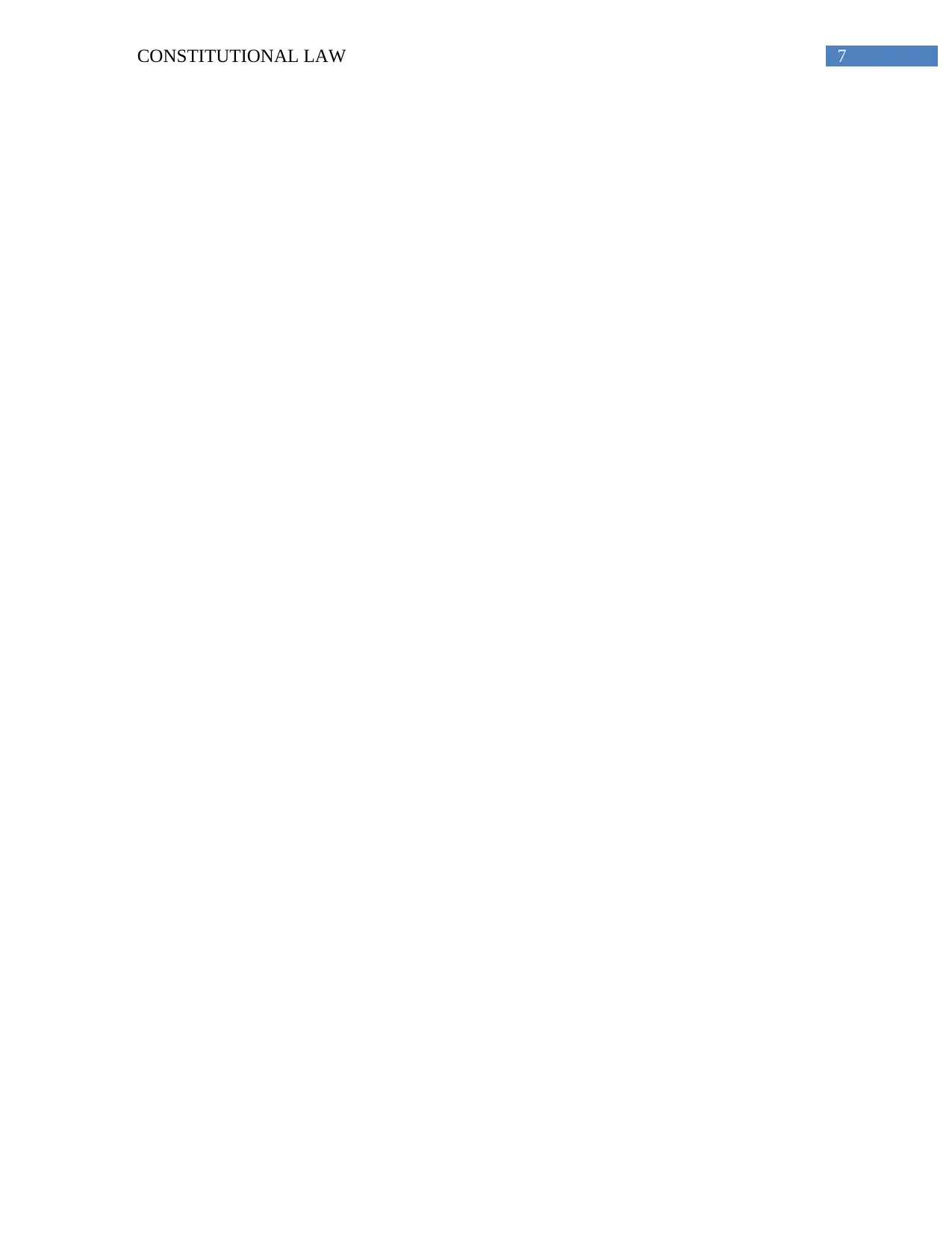
7CONSTITUTIONAL LAW
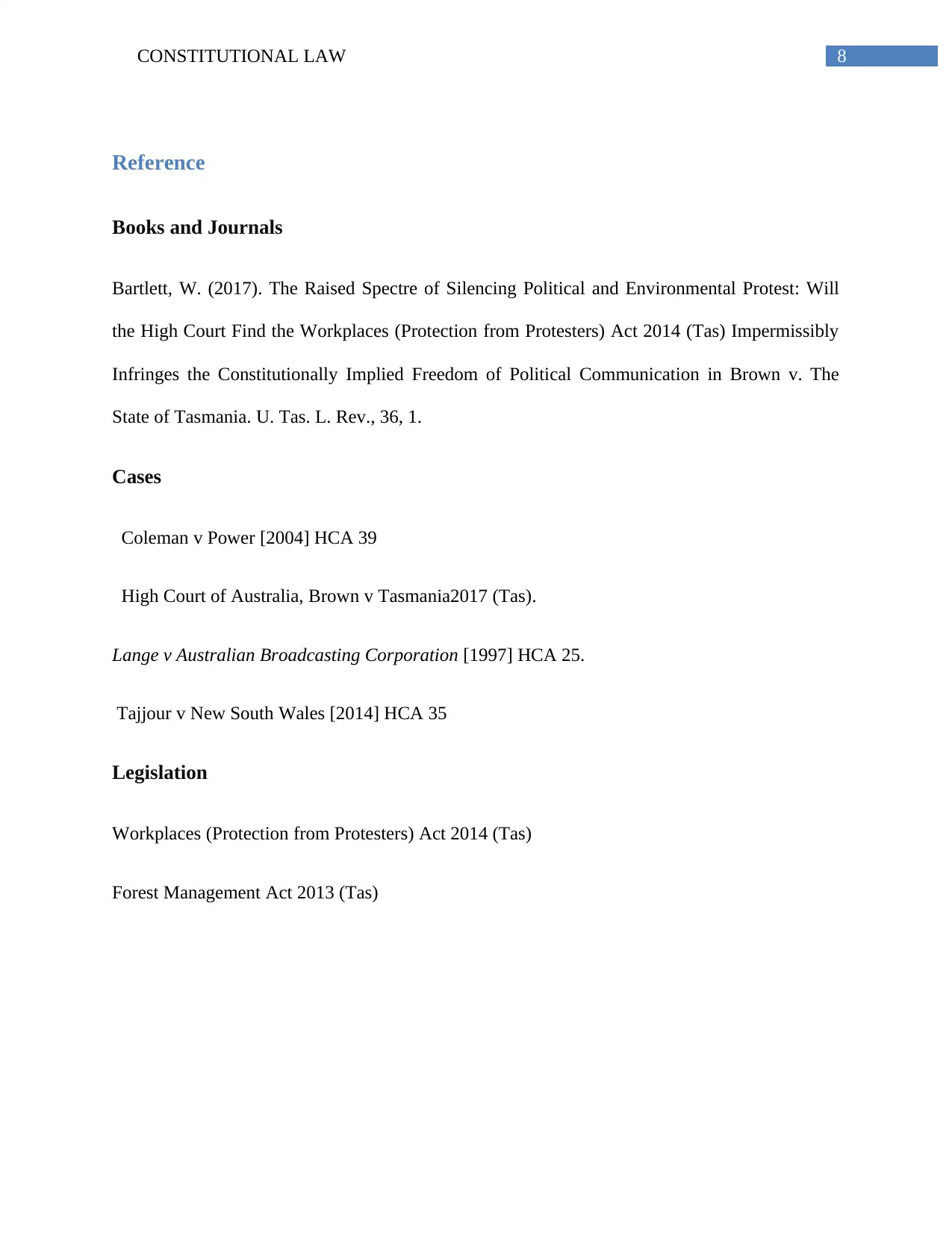
8CONSTITUTIONAL LAW
Reference
Books and Journals
Bartlett, W. (2017). The Raised Spectre of Silencing Political and Environmental Protest: Will
the High Court Find the Workplaces (Protection from Protesters) Act 2014 (Tas) Impermissibly
Infringes the Constitutionally Implied Freedom of Political Communication in Brown v. The
State of Tasmania. U. Tas. L. Rev., 36, 1.
Cases
Coleman v Power [2004] HCA 39
High Court of Australia, Brown v Tasmania2017 (Tas).
Lange v Australian Broadcasting Corporation [1997] HCA 25.
Tajjour v New South Wales [2014] HCA 35
Legislation
Workplaces (Protection from Protesters) Act 2014 (Tas)
Forest Management Act 2013 (Tas)
Reference
Books and Journals
Bartlett, W. (2017). The Raised Spectre of Silencing Political and Environmental Protest: Will
the High Court Find the Workplaces (Protection from Protesters) Act 2014 (Tas) Impermissibly
Infringes the Constitutionally Implied Freedom of Political Communication in Brown v. The
State of Tasmania. U. Tas. L. Rev., 36, 1.
Cases
Coleman v Power [2004] HCA 39
High Court of Australia, Brown v Tasmania2017 (Tas).
Lange v Australian Broadcasting Corporation [1997] HCA 25.
Tajjour v New South Wales [2014] HCA 35
Legislation
Workplaces (Protection from Protesters) Act 2014 (Tas)
Forest Management Act 2013 (Tas)
⊘ This is a preview!⊘
Do you want full access?
Subscribe today to unlock all pages.

Trusted by 1+ million students worldwide
1 out of 9
Your All-in-One AI-Powered Toolkit for Academic Success.
+13062052269
info@desklib.com
Available 24*7 on WhatsApp / Email
![[object Object]](/_next/static/media/star-bottom.7253800d.svg)
Unlock your academic potential
Copyright © 2020–2025 A2Z Services. All Rights Reserved. Developed and managed by ZUCOL.